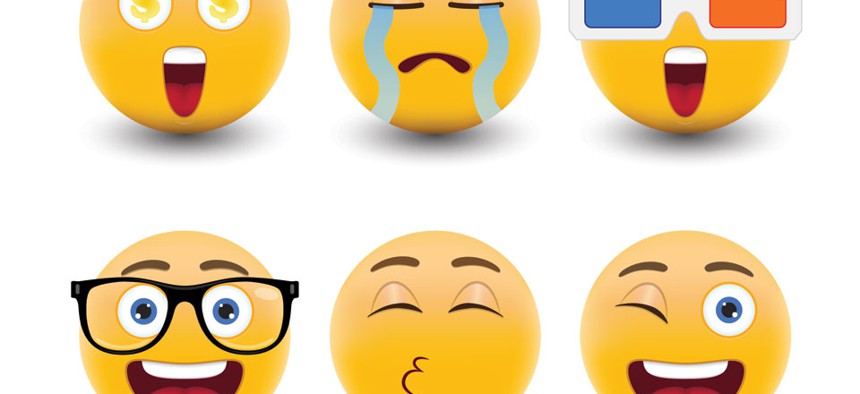Why the White House Is Using Emoji

CoolKengzz/Shutterstock.com
In a report about the status of the nation's millennial population, Washington relied heavily on emojis and graphics, abandoning words almost altogether.
On Wednesday, the White House Council of Economic Advisors released a report about the status of Millennials across the nation, touching on education, debt, and healthcare rates.
The report is modeled after a listicle typical of Buzzfeed or BoredPanda—" 15 Economic Facts About Millennials "—and it comes with an accompanying infographic full of ... emoji.

Though much of the report paints a happy picture of being a 20-something in America, it isn't all rosy: Student debt is on the rise and the unemployment rate remains elevated. To cover the three most important facets (college education and student debt, technology, and healthcare) of the report, the White House relies heavily on emoji, weaving them haphazardly through the infographic, in an attempt to reach out to the generation which most heavily relies on emoticons for communication.
"This is an example of what we heard about back in 2008, Obama using digital technologies to excite a new, younger demographic," Natalia Mehlman-Petrzela, an assistant professor of history at the New School University, explained. "In the world of Twitter and Instagram, millennials are using emojis more and more, so it makes sense to use that strategy to appeal to people."
Emoji, in other words, are a roundabout way to generate fellow feeling. And sure enough, this report starts with a clap—the applause hands emoji, to be precise. Applause hands was one of the original emoji available to iPhone users, and one of the symbols that bridged the gap between emoji and the more primitive emoticon.
A brief history: Emoji were born out of emoticons, but emoji experts are careful to distinguish between them. iEmoji , a forum dedicated to the little pictures, defines emoticons as "user-created images from text so the possible combinations is infinite" (sic), like :-) or :-(. Emoji, meanwhile, are characters: "codes meant to be read and transferred by computers then decoded into pre-defined images users can see." There is an endless number of emoticons, but a limited number of emoji.
The smiley is the first known emoticon, created in 1982 by Scott Fahlman , a Carnegie Mellon University researcher. But the emoji didn’t come along until much later:Shigetaka Kurita invented the first one in 1999 while working at NTT Docomo, the primary mobile phone operator in Japan.
NTT Docomo first began experimenting with emojis in 1995, when they added a heart symbol to their pagers . In 1999, Kurita became the first official emoji designer, developing the concept while working on the i-mode project, " the world’s first major mobile Internet system ." He told The Wall Street Journal his original designs were inspired by manga, Chinese characters and street signs: The first outcome of this inspiration included happy and sad faces, a music note, a punch, and a kiss. Kurita was never able to patent his creation and emojis slowly creeped onto other development platforms, becoming increasingly more complex and realistic.
Though they have been around for the last 15 or so years, emoji was introduced to American audiences in 2010-2011. That was when the Unicode Consortium released hundreds of emoji in Version 6.0 of their ubiquitous standard. Unicode is the standard for sharing computer text digitally. Several months later, Apple’s iOS 5 was launched, which included an emoji keyboard. (Again, this is for American audiences: The Verge has found Japanese users who integrated Japanese telecom firm Softbank's emoji into iOS 2.2.)
Ram Menon , CEO of Avaamo , a business-specific emoji app, considers humanity's brief foray into the written word stranger than the whole-hearted adoption of the emoji.
"We have been communicating with pictures since the beginning of time, and we lost that for some time. Now, writing is almost non-existent, and we are moving to typing," he told me. "Every group has their own lingua franca."
Just like when your parents started saying "YOLO" or "Word," the White House is trying to be cool, catching up on the hip, young lingo, or lack of lingo in this case.
While the White House is making a formidable effort of reaching out to Millennials, Mehlman-Petrzela points out they may inadvertently be offending their target audience.
"I am most curious to see if this is something millennials find offensive or engage with it. I don't think he is trying to say, 'millennials don't know how to read,' or 'this is the only way they can be reached,' but I think a millennial could find this tremendously infantilizing," she said. "And a lot of the data [in the report] suggests, based on the White House's own conclusions, millennials are anything but unserious and anything but over-playful. They are more focused on their studies than other generations have been, more focused on their businesses, so one would think the White House would and does realize that the millennial generation is more than capable of reading, not just looking at cute pictures."
Political emoji are just another trend, another appeal to common cause. Right now, the White House has decided to chatspeak to us—but if an iambic pentameter app becomes all the rage next year, expect a sonnet.
( Image via CoolKengzz / Shutterstock.com )
NEXT STORY: Android OS: Closing the Door on Open Source?


